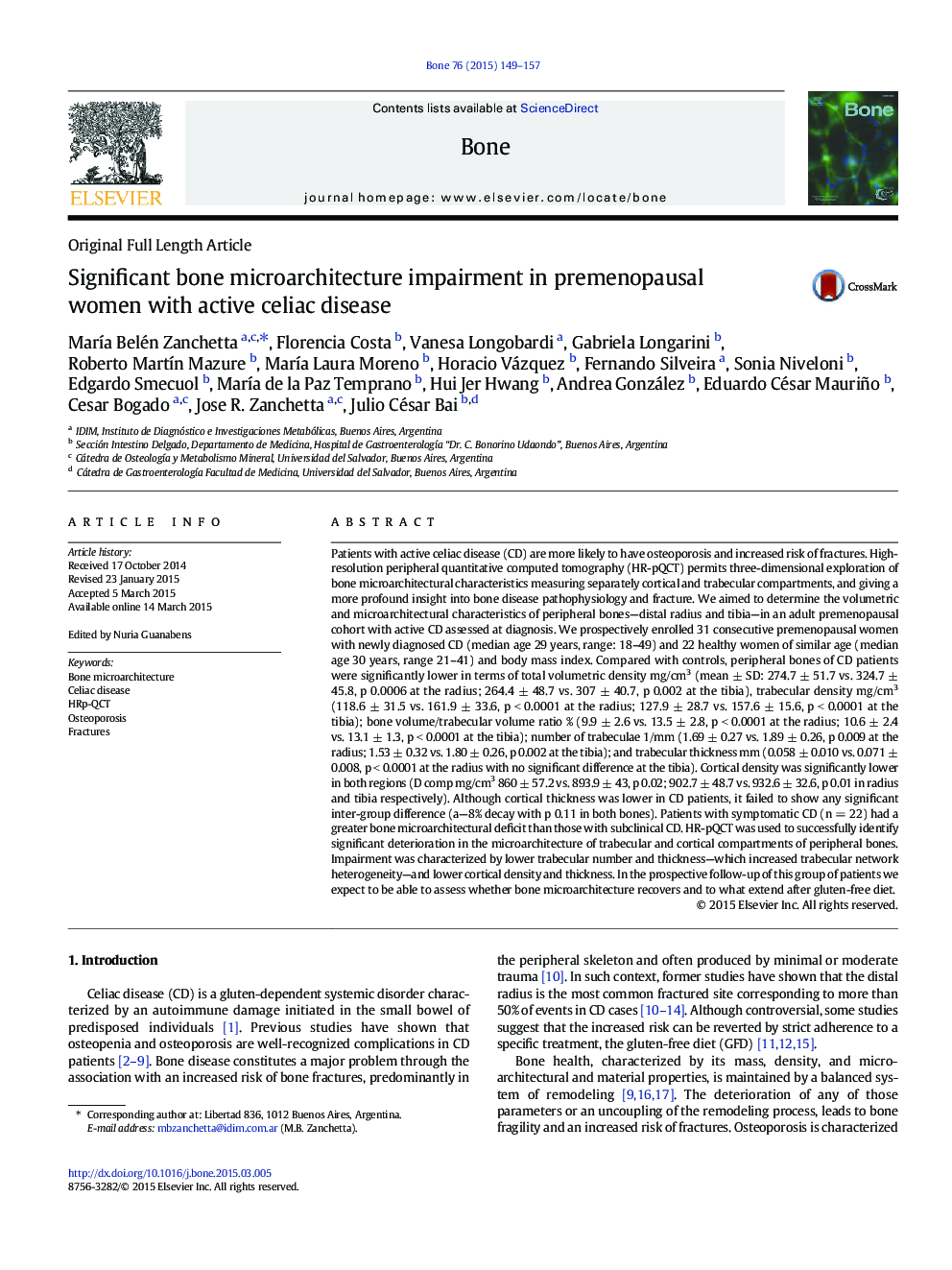| کد مقاله | کد نشریه | سال انتشار | مقاله انگلیسی | نسخه تمام متن |
|---|---|---|---|---|
| 5889565 | 1568143 | 2015 | 9 صفحه PDF | دانلود رایگان |
عنوان انگلیسی مقاله ISI
Significant bone microarchitecture impairment in premenopausal women with active celiac disease
ترجمه فارسی عنوان
اختلال میکروارگانیخته های استخوانی در زنان یائسه مبتلا به بیماری سلیاک فعال
دانلود مقاله + سفارش ترجمه
دانلود مقاله ISI انگلیسی
رایگان برای ایرانیان
کلمات کلیدی
موضوعات مرتبط
علوم زیستی و بیوفناوری
بیوشیمی، ژنتیک و زیست شناسی مولکولی
زیست شناسی تکاملی
چکیده انگلیسی
Patients with active celiac disease (CD) are more likely to have osteoporosis and increased risk of fractures. High-resolution peripheral quantitative computed tomography (HR-pQCT) permits three-dimensional exploration of bone microarchitectural characteristics measuring separately cortical and trabecular compartments, and giving a more profound insight into bone disease pathophysiology and fracture. We aimed to determine the volumetric and microarchitectural characteristics of peripheral bones-distal radius and tibia-in an adult premenopausal cohort with active CD assessed at diagnosis. We prospectively enrolled 31 consecutive premenopausal women with newly diagnosed CD (median age 29 years, range: 18-49) and 22 healthy women of similar age (median age 30 years, range 21-41) and body mass index. Compared with controls, peripheral bones of CD patients were significantly lower in terms of total volumetric density mg/cm3 (mean ± SD: 274.7 ± 51.7 vs. 324.7 ± 45.8, p 0.0006 at the radius; 264.4 ± 48.7 vs. 307 ± 40.7, p 0.002 at the tibia), trabecular density mg/cm3 (118.6 ± 31.5 vs. 161.9 ± 33.6, p < 0.0001 at the radius; 127.9 ± 28.7 vs. 157.6 ± 15.6, p < 0.0001 at the tibia); bone volume/trabecular volume ratio % (9.9 ± 2.6 vs. 13.5 ± 2.8, p < 0.0001 at the radius; 10.6 ± 2.4 vs. 13.1 ± 1.3, p < 0.0001 at the tibia); number of trabeculae 1/mm (1.69 ± 0.27 vs. 1.89 ± 0.26, p 0.009 at the radius; 1.53 ± 0.32 vs. 1.80 ± 0.26, p 0.002 at the tibia); and trabecular thickness mm (0.058 ± 0.010 vs. 0.071 ± 0.008, p < 0.0001 at the radius with no significant difference at the tibia). Cortical density was significantly lower in both regions (D comp mg/cm3 860 ± 57.2 vs. 893.9 ± 43, p 0.02; 902.7 ± 48.7 vs. 932.6 ± 32.6, p 0.01 in radius and tibia respectively). Although cortical thickness was lower in CD patients, it failed to show any significant inter-group difference (a-8% decay with p 0.11 in both bones). Patients with symptomatic CD (n = 22) had a greater bone microarchitectural deficit than those with subclinical CD. HR-pQCT was used to successfully identify significant deterioration in the microarchitecture of trabecular and cortical compartments of peripheral bones. Impairment was characterized by lower trabecular number and thickness-which increased trabecular network heterogeneity-and lower cortical density and thickness. In the prospective follow-up of this group of patients we expect to be able to assess whether bone microarchitecture recovers and to what extend after gluten-free diet.
ناشر
Database: Elsevier - ScienceDirect (ساینس دایرکت)
Journal: Bone - Volume 76, July 2015, Pages 149-157
Journal: Bone - Volume 76, July 2015, Pages 149-157
نویسندگان
MarÃa Belén Zanchetta, Florencia Costa, Vanesa Longobardi, Gabriela Longarini, Roberto MartÃn Mazure, MarÃa Laura Moreno, Horacio Vázquez, Fernando Silveira, Sonia Niveloni, Edgardo Smecuol, MarÃa de la Paz Temprano, Hui Jer Hwang,
